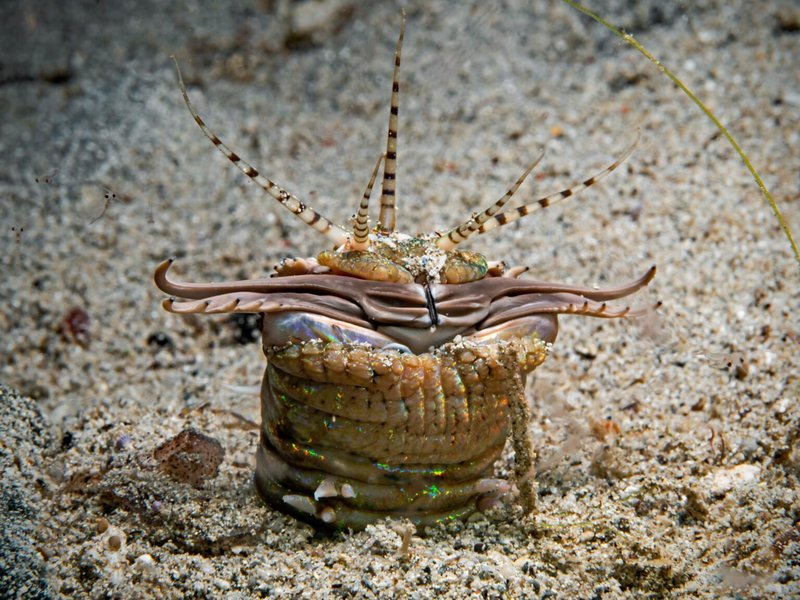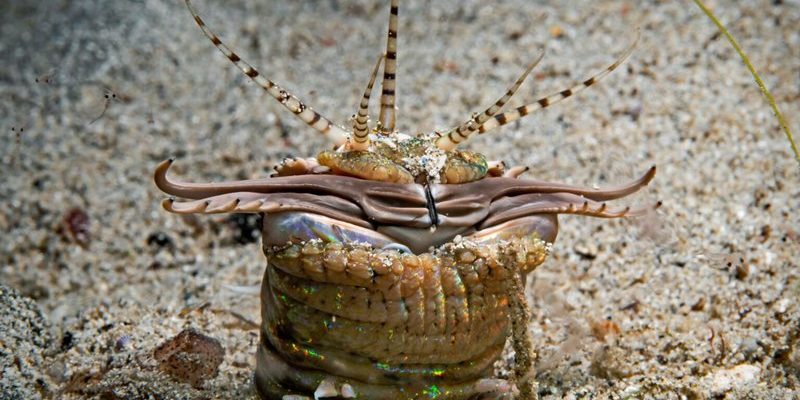
Picture this: you’re at a beach, watching crabs scurrying along the shore, and beneath the waves, vibrant creatures are dancing in the current. Among these is the Bobbit worm, a captivating predator. As these worms grow, they go through various changes that help them thrive in their environments. Understanding these **molting** patterns not only sheds light on their biology but also highlights the adaptations that allow them to survive in the ocean’s depths.
What Are Bobbit Worms?
Before we delve into their growth patterns, let’s clear up what exactly a Bobbit worm is. Known scientifically as *Eunice aphroditois*, these marine polychaetes belong to the family Eunicidae. They’re long, segmented creatures that can reach up to 10 feet in length, although most are much smaller. With a body resembling a flexible, colorful ribbon, Bobbit worms have a unique hunting method. They bury themselves in the sand or mud, leaving only their deadly jaws exposed, ready to ambush unsuspecting prey.
You might be wondering why they’re called Bobbit worms. The name comes from a rather infamous tale involving a certain individual who famously cut off her husband’s… well, you get the idea. Bobbit worms are known for their ability to strike quickly. Their powerful jaws snap shut with lightning speed, making them formidable predators in their underwater realm.
The Importance of Molting
Molting is a natural and essential process for many arthropods and some marine organisms, including Bobbit worms. Essentially, it’s when they shed their outer exoskeleton to allow for growth. Imagine wearing a tight pair of shoes; after a while, they become uncomfortable. You’d need to get a new pair, right? For Bobbit worms, molting serves a similar purpose, enabling them to grow larger and continue thriving in their habitats.
But molting isn’t just about growth. It’s also a way for Bobbit worms to remove parasites and damaged tissue, making it a crucial part of their health. When it’s time to molt, they will usually retreat into their burrows for protection, ensuring they’re safe while they shed their old skin. This strategic move speaks volumes about their instinctual behaviors.
How Often Do Bobbit Worms Molt?
You might be curious about how frequently these fascinating creatures molt. On average, Bobbit worms can molt several times a year, depending on their age and environmental conditions. Younger worms tend to molt more frequently than older ones. It’s like how teenagers seem to outgrow their clothes every few months. As they age, the frequency of molting slows down.
Environmental factors, such as temperature and food availability, can influence the molting process as well. Warmer waters and abundant food often encourage more frequent molting. However, if conditions are less than ideal, their growth and molting patterns may slow down, showcasing the direct connection between their environment and biology.
The Molting Process: Step by Step
So, how does the actual molting process work for Bobbit worms? Here’s a simplified breakdown:
- Preparation: As the worm prepares to molt, it stops eating and retreats into its burrow. This is when it’s most vulnerable.
- Shedding: The old skin splits, often starting at the head, allowing the worm to wriggle free.
- Expansion: Once free, the new, soft skin is expanded with water, allowing it to grow larger.
- Hardening: Finally, the new skin hardens over the next few hours, providing the worm with a new, protective layer.
It’s fascinating to realize that while Bobbit worms seem so alien to us, their molting process mirrors some aspects of our own growth. Just like how we shed old habits or thoughts, they shed their old skin to embrace a new stage of life.
Growth Patterns of Bobbit Worms
Bobbit worms grow in a segmented manner, which is pretty cool. Each segment can potentially regenerate, meaning that if a part of the worm is lost, it can grow back. This makes them incredibly resilient. As they grow, their segments increase in length and size, creating a longer and more formidable predator over time.
Interestingly, the growth rate can vary between individuals. Factors like diet, age, and living conditions all play a role in how quickly they can grow. A well-fed worm in a stable environment will generally grow faster compared to one that’s struggling to find food or is stressed by unfavorable conditions.
Why Understanding Their Growth Matters
You might be wondering why knowing about Bobbit worm molting and growth patterns is important. Well, it sheds light on the health of marine ecosystems. Bobbit worms are a vital part of their food chain, serving as both predator and prey. By understanding how these worms grow and adapt, scientists can gain insights into the overall health of their ecosystems.
Additionally, as we deal with changing ocean conditions due to climate change, knowing how creatures like Bobbit worms respond to their environments can help us predict broader environmental impacts. It’s a reminder that every piece of the ecosystem is connected, and even the smallest creatures can have a significant role to play.
Bobbit worms might seem a bit strange at first glance, but their ability to molt and grow teaches us so much about resilience, adaptation, and the intricate balance of marine life. Just like shedding old beliefs to make way for new growth, these tiny predators undergo a fascinating transformation throughout their lives. By understanding their molting and growth patterns, we can appreciate not only their unique biology but also the delicate ecosystems they inhabit.
So, next time you think about the ocean, let your mind wander beyond the typical images. Explore the wonders of creatures like the Bobbit worm, and you might find yourself captivated by the mysteries of the deep.

